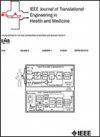激光散斑灌注成像在离体肝脏模型中的可行性
IF 4.4
3区 医学
Q2 ENGINEERING, BIOMEDICAL
IEEE Journal of Translational Engineering in Health and Medicine-Jtehm
Pub Date : 2025-09-03
DOI:10.1109/JTEHM.2025.3602158
引用次数: 0
摘要
目的:发展微循环灌注评价方法对评价离体器官保存过程中器官状态和扩大供体池具有重要意义。本研究利用激光多普勒灌注成像(LDPI)和激光散斑对比成像(LSCI)两种非接触式成像技术,论证了恒温机器灌注下离体肝脏模型微循环灌注成像的可行性。方法和步骤:离体猪肝脏灌注氧合血3小时。每30分钟从肝动脉和门静脉采集血液,评估肝脏的整体状况。使用内部开发的LDPI和无线LSCI设备每15分钟对五个肝叶进行成像。分析时间平均灌注图以评估时空血流量。然后评价LDPI与LSCI灌注指标的相关性。结果:时空灌注图像显示详细的浅表微循环灌注跨越5个成像叶。LDPI与LSCI指数呈高度相关(${R}^{2}=0.81$),脑叶灌注良好。血乳酸水平随着时间的推移而增加,表明由于缺血导致代谢活动的改变。LSCI灌注指数与pH值的相关性(${R}^{2}_{\max .}=0.95$)。结论:在可控的实验条件下,离体肝脏模型模拟了体内灌注。LDPI和LSCI提供了快速、独立的局部微循环血流评估,显示了高度的技术间相关性,并反映了肝脏状况的整体恶化,如血气参数所证明的那样。意义:一种紧凑的无线LSCI系统-通过ldpi验证-可以无创评估微循环状态,并作为评估深层组织活力的补充工具。临床和转化影响声明-我们介绍了一种无线,紧凑,非接触式LSCI系统(经LDPI验证),可在机器灌注期间进行微循环评估,补充深层组织医学成像方法和血气分析,以增强器官活力评估并支持移植前治疗决策(类别:临床前研究)。本文章由计算机程序翻译,如有差异,请以英文原文为准。
Feasibility of Laser Speckle-Based Perfusion Imaging in an Ex-Vivo Liver Model
Objective: Advancing microcirculatory perfusion assessment methods is crucial for evaluating organ status during ex-vivo organ preservation and expanding the donor pool. This study demonstrates the feasibility of microcirculatory perfusion imaging in an ex-vivo liver model under normothermic machine perfusion, using two non-contact imaging techniques: laser Doppler perfusion imaging (LDPI) and laser speckle contrast imaging (LSCI).Methods and procedures: An ex-vivo porcine liver was perfused with oxygenated blood for 3 hours. Blood samples were collected every 30 minutes from the hepatic artery and portal vein to evaluate the liver’s overall status. Each of the five liver lobes was imaged every 15 minutes using both the in-house developed LDPI and wireless LSCI devices. Temporally averaged perfusion maps were analyzed to assess spatiotemporal blood flow. Then, correlations between LDPI and LSCI perfusion indices were evaluated.Results: Spatiotemporal perfusion images showed detailed superficial microcirculatory perfusion across five imaged lobes. High correlations between LDPI and LSCI indices were observed in lobes $3-5$ ( ${R}^{2}=0.81$ ), which were well-perfused. Blood lactate levels increased over time, indicating a shift in metabolic activity due to ischemia. Also, correlation of LSCI perfusion indices with pH ( ${R}^{2}_{\max .}=0.95$ ) was observed.Conclusion: The ex-vivo liver model mimics in-vivo perfusion under controlled experimental conditions. LDPI and LSCI provide rapid, independent assessments of local microcirculatory blood flow, demonstrate a high inter-technique correlation, and reflect the overall deterioration of liver status, as evidenced by blood gas parameters.Significance: A compact, wireless LSCI system—validated against LDPI—enables non-invasive evaluation of microcirculatory status and serves as a complementary tool for assessing deep tissue viability. Clinical and Translational Impact Statement—We introduce a wireless, compact, and non-contact LSCI system (validated by LDPI) enabling microcirculatory assessment during machine perfusion, complementing deep tissue medical imaging methods and blood gas analysis to enhance organ viability evaluation and support pre-transplantation treatment decisions (Category: Pre-Clinical Research).
求助全文
通过发布文献求助,成功后即可免费获取论文全文。
去求助
来源期刊

IEEE Journal of Translational Engineering in Health and Medicine-Jtehm
Engineering-Biomedical Engineering
CiteScore
7.40
自引率
2.90%
发文量
65
审稿时长
27 weeks
期刊介绍:
The IEEE Journal of Translational Engineering in Health and Medicine is an open access product that bridges the engineering and clinical worlds, focusing on detailed descriptions of advanced technical solutions to a clinical need along with clinical results and healthcare relevance. The journal provides a platform for state-of-the-art technology directions in the interdisciplinary field of biomedical engineering, embracing engineering, life sciences and medicine. A unique aspect of the journal is its ability to foster a collaboration between physicians and engineers for presenting broad and compelling real world technological and engineering solutions that can be implemented in the interest of improving quality of patient care and treatment outcomes, thereby reducing costs and improving efficiency. The journal provides an active forum for clinical research and relevant state-of the-art technology for members of all the IEEE societies that have an interest in biomedical engineering as well as reaching out directly to physicians and the medical community through the American Medical Association (AMA) and other clinical societies. The scope of the journal includes, but is not limited, to topics on: Medical devices, healthcare delivery systems, global healthcare initiatives, and ICT based services; Technological relevance to healthcare cost reduction; Technology affecting healthcare management, decision-making, and policy; Advanced technical work that is applied to solving specific clinical needs.
 求助内容:
求助内容: 应助结果提醒方式:
应助结果提醒方式:


